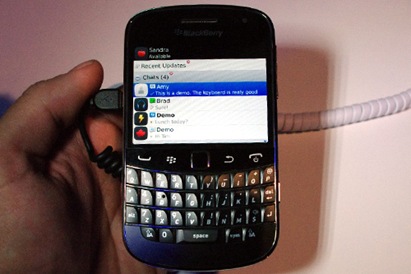Although RIM already offers touchscreen-based devices, including the Storm series and Torch, many BlackBerry purists voiced frustration with the user experience. The Storms lack a hardware keyboard for quick typing, while the Torch, despite its QWERTY slider, did not appear to be well received in the market. The company has finally decided to adapt its iconic BlackBerry form-factor with a touchscreen, rather than diverging from the classic hardware.
We liked many of the aesthetic improvements to the hardware. Like the iPhone 4, the 9900 is built around a stainless steel frame. The brushed stainless edge is paired with a weaved-glass material on the battery cover, resulting in a modern look that still retains the looks of previous Bolds. All of the new features are packed into a housing that measures 10.5mm thick, making the device much thinner than the Torch and slightly thinner than the other Bolds. The design still integrates a removable battery, though any estimates surrounding battery life remain unclear.
The company claims the 9900 integrates "the best keypad we've ever produced," and we found the design to be much better than the QWERTY slider on the Torch. Users can expect the keyboard experience to be similar to that of the existing Bold lineup, but with slightly concave key surfaces.
Internally, the new BlackBerry integrates a 1.2GHz processor and a GPU to help boost graphics performance. We did not notice any lag or delay with the graphics of the UI or various apps, although the beta software sometimes experienced a delay when attempting to open certain apps. In general, we found the UI and touchscreen responsiveness to be snappy and comparable in speed to many Android handsets and the iPhone. The speed improvements were particularly apparent when browsing through websites.
Aside from the under-the-hood tweaks to BlackBerry OS, users will find higher levels of customizability and slight changes to the icons. We liked NFC integration and the new Balance feature, which provides a system for separating enterprise data from personal features. Users can also take advantage of 720p video recording from the five-megapixel sensor.
Overall, we were impressed with the wide range of improvements that have been made to the classic Bold design. It seems unusual that RIM waited this long to build a touchscreen Bold, but the offering does seems more refined than the Torch or the Storm. The 9900 is the perfect device for anyone who wants to take advantage of a touchscreen interface without making sacrifices to typing speed.
RIM promises the new Bold to arrive in summer or late summer. The device will be available in two variations: the GSM-based 9900 and the dual-mode CDMA/GSM 9930.

No comments:
Post a Comment